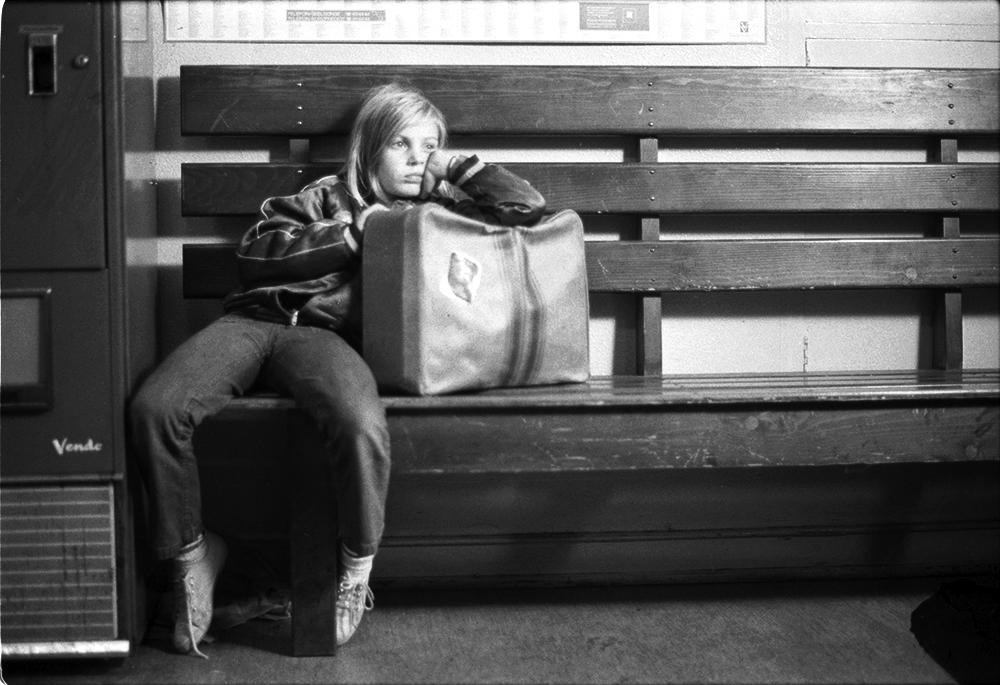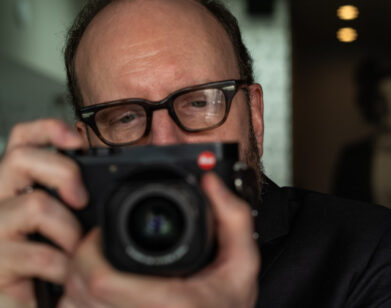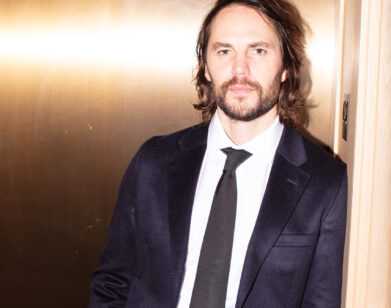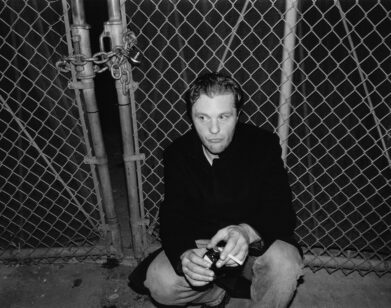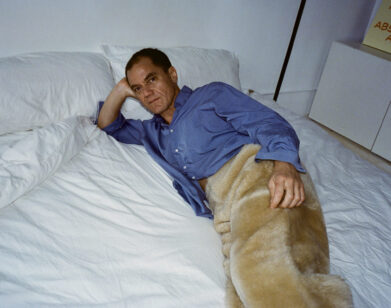The Road to Wim Wenders
Perhaps no one else has articulated existential malaise quite like Wim Wenders. The secret may be that, like the ragged bands of unmoored loners and drifters that populate his body of work, the filmmaker has spent much of his career searching for ways to redefine his cinematic vision. Growing up in Düsseldorf, Wenders, now 70, consumed a cultural diet of Elvis Presley and Hollywood westerns. Freewheeling American iconography made a lasting impact on him, and has burrowed deep into many of his films, which have put meticulously framed shots of Eastern seaboard motels and strip malls (Alice in the Cities, 1974) into dialogue with desolate stretches of the East and Western German border (Kings of the Road, 1976); panoramic shots of the American West (Paris, Texas, 1984); the metaphysical, angel-dwelling space above a divided Berlin (Wings of Desire, 1987); along with idiosyncratic signage, jukeboxes, and of-the-moment pop music. In the ’70s, along with his countrymen Werner Herzog and Rainer Werner Fassbinder, Wenders proposed an alternative language to the crippled post-war state of German film, and emerged as the most unflinchingly humane of the three. Despite the shifts over his over four-decade long career, from his experiments in documentary, in 3-D, and his own approach to the road movie, Wenders has not just refigured form, but remained an uncompromising stylist.
Now, selections from Wenders’ 40-odd-year catalog, in new restorations, will go cross-country in the traveling retrospective “Wim Wenders: Portraits Along the Road,” currently playing at IFC Center in New York until September 24th. The retrospective features, among others, The Goalie’s Anxiety at the Penalty Kick [1971]; his ferociously stunning adaptation of Patricia Highsmith’s Ripley’s Game, The American Friend [1977]; a director’s cut of his divisive around-the-world epic Until the End of the World [1991]; The State of Things [1982]; Paris, Texas; Wings of Desire; an early shorts program; and documentaries, including his tribute to YasujirÅ Ozu, Tokyo-Ga [1985]; his portrait of Yohji Yamamoto, Notebooks on Cities and Clothes [1989]; and 2011’s experimental 3-D work Pina; as well as his upcoming feature Every Thing Will Be Fine.
Interview recently spoke with the director at the Criterion Collection’s HQ in New York.
COLLEEN KELSEY: You’ve recently restored a number of your earlier works. What is your relationship to these films now, considering some were created over 40 years ago? Are you still very deeply connected to them?
WIM WENDERS: Well, I had to reconnect not only to these movies, but also to who I was in 1971 or whenever. The oldest one we restored was the The Goalie’s Anxiety at the Penalty Kick [1971], which was the first time I ever came to New York in January of 1972, to the first edition of MoMA’s New Directors season. So I was a kid. Restoring the film 43 years later was reconnecting to the kid that made it, and that is not that easy. But on the other hand, restoration by its very name and by its very condition: you are not remaking anything, you are trying to let it shine the way it was supposed to. I had to understand what the kid wanted to say at the time, and refrain from changing it. It was fun because sometimes you just ask yourself, “How the heck did I come up with that? How did I do that?” A lot of it is, of course, quite naïve. Forty years later you would do things quite differently. But it was a nice discovery, because sometimes you see your mistakes quite clearly and you cannot do anything about them.
KELSEY: Was that your first time in the States, coming to MoMA?
WENDERS: That was my first very first night in New York, late January 1972. It seems to me that I remember every second of this as I was here for five days. I don’t think I slept in those five days because it was just too precious to me. I stayed at the Algonquin, around the corner from MoMA. I just stared at the buildings. It was so unbelievable. I was the very first of all my friends and all the people I knew. Nobody had been in New York, of course. I had seen all the movies. I could have just as well saved the money for the hotel.
KELSEY: And what was the first time you traveled to rural America?
WENDERS: The first two or three times I never left New York, because it was too much already. The first time I traveled was a couple years later; I think the first time I got out of New York was to start shooting Alice in the Cities [1974]. Actually, I had never been south of New York. We traveled south with just two cars, and we didn’t know how far we’d have to go because I had not been in Virginia or anywhere. I had this dream that we would start the movie wherever there were palm trees. We got to North Carolina and then there were finally palm trees. That’s when we started to make the film. At that moment I had never been there. Later on, of course, I crossed the country several times by car. By bus first, then by car driving myself. Probably I have crossed America more than most Americans, except for Sam Shepard, because he only drives.
The first time I got to know rural America, I was shocked. None of these little towns looked different from each other, I felt. You had to travel for a long time for things to change. The entire middle of the country looked like one big place where everything resembled each other. I got to know [it] better later, but you would get out and didn’t know if you would travel north, south, east or west. It all looked the same. But then I really discovered the South and I went to the West and northern points of this country. But my first discovery was a shock, because New York was so unique, and the rest of the country was the opposite of unique. Same gas stations, same motels, same fast food chains, and you never knew if you were already in the next town or still the previous one. The thing is, Europe looks like that today too. You drive through France you think you are driving through America, I am not kidding.
KELSEY: Alice in the Cities was really your first road movie. What about working on that film unlocked the genre for you?
WENDERS: Frankly, I didn’t know the genre existed. I must have seen some movies, I think I saw Detour [1945], but I didn’t recognize it as a genre. Of course I knew a lot of westerns, if there was any precursor to those movies it was the western. But I didn’t know you could make movies while traveling. I didn’t know you could actually get in a car, start a story, and the itinerary and story would become the same. While we made Alice in the Cities, I found out. I felt like a fish in the water. This was the kind of filmmaking I was born for. It gave an incredible freedom, because it did allow, for once, to shoot the film in chronological order. In a road movie, you start at A and you go to B, C, D, and you arrive at a certain road. I thought it was so fabulous, because it allows you, at any given point, to change the course of the movie. In regular filmmaking you can never, ever do that because most filmmaking circumstances, you often shoot the ending before the beginning. You have no leeway to change anything. In a road movie, you have total freedom. It encourages you to go left instead of right. It encourages you to come up with better ideas than you had when you were writing the script. I loved it, and I loved it so much I made the next five or six films like that.
KELSEY: Did you find that that format was also a good fit for these emotional and psychologically transient characters you created?
WENDERS: They were drifters and searchers and they looked for something. The journey was a state of mind for them. And also, the filmmaking journey is a way of working that allows you to experience what the film is about, and to have the adventure that the film is supposed to represent for the audience. Most adventure films are made by film crews who are not going for the adventure. They are pretending to do the adventure. In a road movie you really go into the adventure, you go into the unknown, and you are faced with the unknown. You are not just producing it, you are experiencing it. I love that more, because the audience will be entering it and witness you actually doing it. That is a fantastic notion.
I didn’t know that at the time. I had made three films already, where I had shot zigzag beginning and the end. I had no freedom. If ever I had to change something, I couldn’t, because I already shot the other scene. The freedom that I discovered with Alice in the Cities, my first road movie, was tremendous. I realized you could actually not really know how the film was going to end. You could make it up. That was so liberating and so much fun. We could still be shooting. It’d be so much fun, we never wanted it to end.
KELSEY: Is it true that Walker Evans’ photography was a big reference for Alice in the Cities?
WENDERS: It was much more a reference for the following one, Kings of the Road [1976]. I think in Alice in the Cities I hadn’t really studied him, but I had some of his books when we shot Kings of the Road and he was a big hero for that film.
KELSEY: What was your usual collaborative process with [cinematographer] Robby [Müller] on the movies that you worked together? What did he bring into it versus what you had developed?
WENDERS: Robby and I made 10 films in a row. We really learned everything together. Robby did his first movie with me, and I didn’t even imagine I could make movies with any other director of photography. For 10 years we did everything together. From the beginning, we had this rule that I would set the shot and Robby would operate the camera and would be completely free to set the light. I wouldn’t interfere with the lighting, but the framing was my job. I insisted on that. I shot my first short films on my own. When Robby was there, it was very clear between the two of us. The frame was my job and the much more difficult task of the lighting was Robby’s. We became a fantastic crew over the ten films. Eventually we didn’t have to speak anymore. A lot of the shots in Paris, Texas [1984] were a result of having worked together for 12 years already. We were like twin brothers. Then eventually I started making films in other circumstances and Robby was not always available. I started making films with other cameramen and Robby worked with other directors, he went on to make movies with Jim Jarmusch, but it was still the closest relationship I’ve ever had with a director of photography. It’s the closest relationship if you’ve really discovered things for the first time. Robby and I really invented a lot together. We just didn’t know how to do it until we did it for the first time.
KELSEY: When did you start taking still photography? Was it something that was a part of the preparation process for a film, or did it start somewhere else?
WENDERS: It started when I was a kid. I had a photo camera when I was six years old. My father was an amateur photographer and he really wanted his son to share that penchant, so I have had a camera ever since I can remember. I photographed my entire life and I always took it for granted, listening to music, breathing, eating. Photography was part of what I did. I took it more seriously and started to do photographs on my own ever since 1983, when I traveled through the American West in preparation for Paris, Texas, completely on my own. Just me photographing, not to prepare for the movie, but to prepare myself for the West’s colors and lights. That’s the first time that I really traveled as a photographer only. Eventually photography and films dissociated. My photography is half my life and it has nothing to do with my movies. I take journeys to take photographs. For me it’s a different profession.
WIM WENDERS: PORTRAITS ALONG THE ROAD WILL RUN UNTIL SEPTEMBER 24 AT IFC CENTER, BEFORE TRAVELING TO 15 CITIES, WITH WIM WENDERS IN PERSON AT SELECT EVENTS. VISIT THE IFC WEBSITE FOR MORE INFORMATION.

